Betabrain Makes Learning Engineering and Science Fun
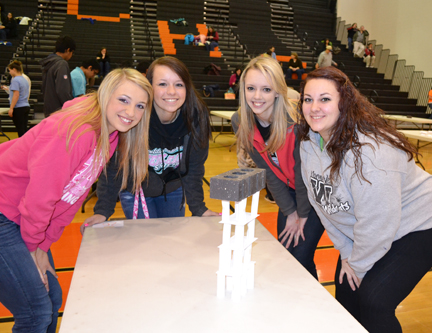
These Betabrain contestants' tower is successfully holding up a brick in "Notecard No Down."
March 13, 2013
Instead of sleeping in on Saturday morning, around 400 McClean County middle school and high school kids showed up at Normal High School in Bloomington on March 8 to participate in Betabrain, a science competition involving hands-on, problem-solving challenges. In its second year, the competition changed its emphasis from solely IT/engineering to include biology, chemistry, and physics.
The first challenge students participated in was "Notecard No Down," which involved building a 30 cm tower using only 25 notecards and 25 cm of tape. The catch: the tower must be sturdy enough to hold a regular-sized brick for a total of 5 seconds.
After successfully completing this first challenge, students with "passports" in hand, eagerly scurried from one end of the building to the other in order to complete the four other challenges in the allotted time. The passports, which told students the order in which they were to do each challenge, needed to be initialed by a Betabrain volunteer in charge of each challenge as they successfully completed the four events.
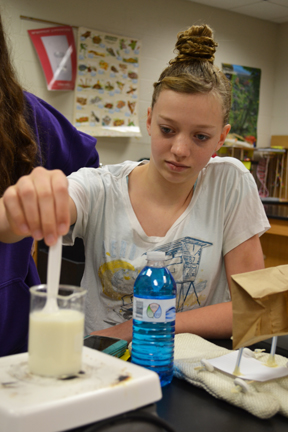
Betabrain contestant stirs her team's milk during the "Say Cheese" challenge.
In the biology challenge, "Say Cheese," students investigated cheese-making. Given the option of choosing one of several variables to explore, such as different kinds of milk, coagulants, or temperatures, students were to discover which of the variables had the most impact on cheese making.
"Battle Chip" challenge, similar to an egg drop exercise, involved students creating a contrivance which would allow a Pringles potato chip to be dropped two stories safely, and not break or crack. Students' test runs were also timed, to see whose would fall the fastest.
In the physics challenge, "Wind Truckin'," students were to create vehicles powered by wind (a box fan) which would travel the length of a table. If a team's vehicle failed to pass the finish line, they had to go back to the drawing board and redesign their vehicle.
Finally, in the chemistry challenge, "Sink It," students explored the properties of gases, specifically water pressure and air pressure. Using two-liter bottles of water, they created Cartesian divers (another small bottle inside the larger bottle). The diver was to go up or down in the bottle when pressure was applied on the outside of the bottle.
Some of the students might have been motivated to be involved in Betabrain based solely on such noble aspirations as love of science or the joy of learning. However, as an extra incentive to participate beyond the fun of hanging out with friends on a Saturday morning instead of doing chores, or getting to run in the halls without reprisal, students had the opportunity to win prizes. Those who completed all of the challenges could compete in drawings for a variety of prizes, including the grand prize, a Kindle Fire.
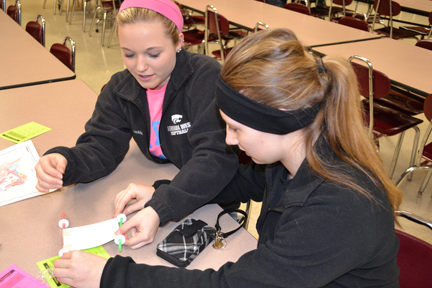
Betabrain contestants designing their vehicle in the"Wind Truckin'" event.
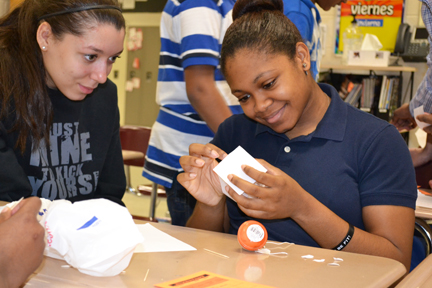
Two contestants work on their design for the "Battle Chip" challenge.
Birthed out of EnLiST (Entrepreneurial Leadership in STEM Teaching & Learning), which is an NSF-funded (National Science Foundation) Math and Science Partnership, Betabrain was created by Lauren Beale from McClean School District and Associate Professor David Brown, from the Curriculum and Instruction Department at Illinois. Originally intended to be the culminating event for an IT project designed as a result of participating in EnLiST, it was expanded to include McClean County District 5 schools. Betabrain organizers, whose goal for next year is to include students from Champaign-Urbana as well as Bloomington, hope that the event will eventually become a state-level competition.
One of the goals of Betabrain, according to Anita Martin, Project Coordinator of EnLiST, in addition to the students having a lot of fun while learning about science and engineering, Betabrain is to help solidify engineering as a part of schools' curriculum. "The next generation science standards include 8 engineering design principles that have to be taught K-12. So we're looking to include engineering in K-12 education. Teachers are not familiar with engineer enough to know how to teach it, so part of ENLIST is engaging teachers in K-12 engineering education. The other part is for us to engage students in engineering-type activities to incorporate physics, chemistry, and biology with engineering, until engineering has its own place in the school."
Does Martin believe that participating in Betabrain could possibly influence some of the students to go on to be scientists or engineers? "I think that there are many high school kids who are born to be engineers, but don't know it. And what I believe this does, it provides an opportunity for them to understand and to realize that part of their passion has to do with principles of engineering, and so it opens up an avenue or career path they may not have realized before."
Story and photographs by Elizabeth Innes, Communications Specialist, I-STEM Education Initiative.
More: 6-8 Outreach, 8-12 Outreach, EnLiST, 2013
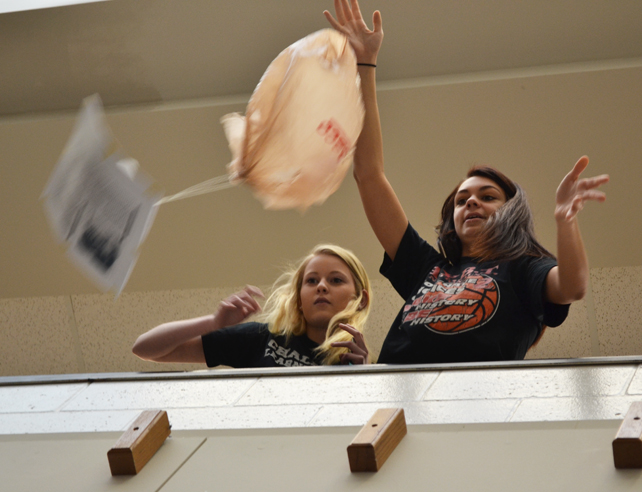
Betabrain contestants test their design during the "Battle Chip" challenge.
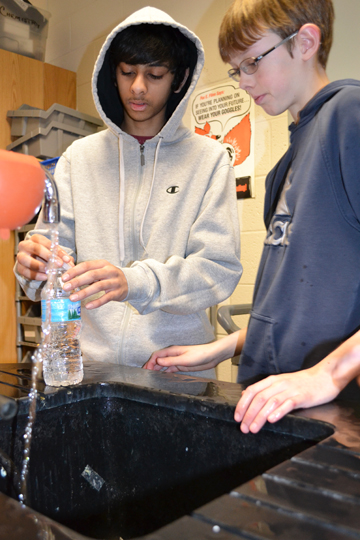
Two contestants prepare their Cartesian Diver for the "Sink It" challenge.













.jpg)
















